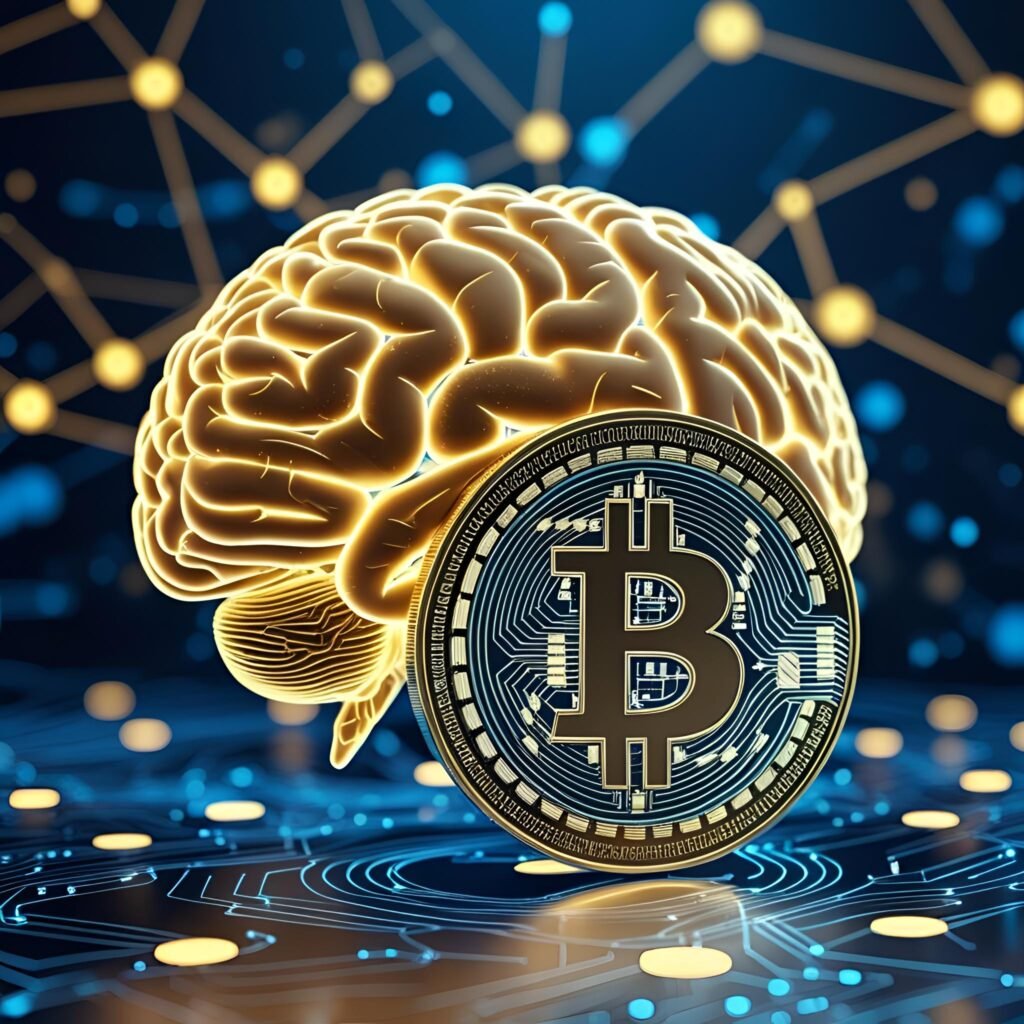
🚀 How I’m Exploring the AI + Crypto Trend Personally
Over the past few months, I’ve seen a surge in interest around AI-based crypto tokens, especially projects like Bittensor’s TAO. These tokens are growing rapidly—as a recent analysis noted, the total market cap exploded from around $2.7 billion to well over $30 billion. That’s massive momentum driven by the convergence of artificial intelligence and blockchain technology Binance+9InvestingHaven+9Gate.com+9.
When I first heard about “AI crypto tokens,” I was skeptical. After all, how much real utility can a blockchain token have in AI development? But as I dug deeper, the possibilities intrigued me—and I decided to take a closer look for myself.
🌟 What Are AI Tokens—and Why Now?
AI tokens are a new class of cryptocurrency assets designed to fuel decentralized artificial intelligence systems. Unlike traditional tokens used purely for payment or speculation, AI tokens have utility: they serve as access keys, incentive models, and governance mechanisms for decentralized AI networks.
Take Bittensor (TAO), for example. This token powers a network where individuals and organizations can contribute machine learning models, training data, or compute resources, and in return, they’re rewarded with TAO tokens. These contributions help train AI systems in a decentralized way — meaning no single corporation owns the data, the model, or the infrastructure.
This model is often compared to Bitcoin mining, but instead of solving cryptographic puzzles, Bittensor nodes contribute real AI value. That could mean training language models, contributing datasets, or helping validate responses. The AI model itself learns from all of these inputs and distributes token rewards based on performance — a novel blend of proof-of-intelligence and proof-of-contribution.
The rise of tokenized governance adds another layer. Holders of AI tokens can vote on proposals, allocate network resources, or decide future development directions. This fosters a more open and democratic AI ecosystem — one where innovation isn’t locked behind paywalls or monopolized by Big Tech.
The real turning point came when AI token projects started integrating with DeFi (Decentralized Finance), making it possible to stake, borrow against, or even yield-farm AI-related tokens. This fusion allowed investors to engage with AI infrastructure while also tapping into familiar crypto financial tools. In short, AI tokens stopped being niche tech tools and started becoming full-fledged financial assets — with momentum.
In just one week in July 2025, the AI token sector reportedly added $10 billion in market value, with TAO leading the charge. This wasn’t just a meme run. It was backed by growing developer activity, validator rewards, and real-world demand for decentralized AI services. Token search volume for “AI crypto,” “Bittensor,” and “AI tokens” spiked across platforms like Google Trends, YouTube, and X (Twitter), signaling mass awareness and a shift toward serious adoption.
The timing couldn’t be better. With rising concerns about AI monopolies and data privacy, decentralized AI offers an alternative — and AI tokens are the infrastructure that make that possible.arXivWikipedia.
📈 Why I Think This Trend Is So High-Conviction
1. Real-world AI Utility + Blockchain Incentives
These tokens aren’t just speculative—they’re tied to real AI services: decentralized machine learning, validation protocols, and distributed compute economics. That’s unique and valuable arXivWikipedia.
2. Attention Drivers Are Huge
The launch of ChatGPT triggered more than 10% return gains in many AI-native crypto assets within months. This shows how public awareness can amplify token demand arXiv.
3. Trend Confirmed by Data
Search queries around “AI tokens,” “BitTensor,” and “AI crypto” have spiked sharply. Analysts report this niche collectively broke $10 billion in one week in mid-2025 The Economic Times.
4. Infrastructure Is Growing
Projects like The Graph, NEAR, NodeGoAI, and others support decentralized AI workflows, showing that infrastructure is aligning with ambitions of token-based AI ecosystems Wikipedia+1Wikipedia+1.

🔍 My Personal Take: Benefits and Reservations
✅ Benefits I See
- Strong upside potential: Early entrants into networks like Bittensor might gain more as adoption grows.
- Community-governed models: Token incentives encourage participation from miners, validators, and innovators.
- AI democratization: Access to AI compute and services becomes accessible via token economics.
- Market hype justified by utility: These tokens are doing real work, not just buzzwords.
⚠️ Risks to Consider
- Scalability issues: Many of these projects rely heavily on off-chain resources or lack full on-chain consensus frameworks InvestingHaven+11Gate.com+11changelly.com+11arXiv.
- Speculative volatility: In 2024 alone, AI-powered crypto scams surged by over 456%, exploiting trust in these technologies timesofindia.indiatimes.com+6ainvest.com+6nypost.com+6.
- Regulatory uncertainty: Tokenization of assets and new DeFi tokens face evolving scrutiny from regulators.
- Overvaluation risk: While TAO reached a ~$3.8B cap recently, the long-term sustainability depends on adoption, node utility, and governance robustness ainvest.com+1theaustralian.com.au+1CoinGecko+4CoinMarketCap+4Gate.com+4.
🧠 What I’m Watching Closely
- Network Activity Growth: Bittensor’s subnet ecosystem just hit nearly $920M in value, showing emerging ecosystem traction InvestingHaven+11The Defiant+11Stocktwits+11.
- Community and Token Supply Health: With ~9.5M tokens circulating out of 21M max, understanding vesting and inflation is key CoinMarketCap+1Gate.com+1.
- Symbolic Dynamics: The wider “machine economy” framing—where AI agents trade, learn, and interact autonomously—could fuel both utility-based and speculative demand blockchain.news.
✏️ What This Means for You (or Anyone Interested)
- Carefully research each AI token—look for real-world usage, validator adoption, staking yields, and ecosystem growth.
- Avoid shiny hype—not all AI tokens offer actual AI services. Some may simply be “AI-themed” without network depth.
- Plan for volatility—if you choose to invest or build with these systems, treat any purchases as part of a high-risk/high-reward model.
- Leverage community tools—follow GitHub updates, TAO.app metrics, Telegram developer chatter, and official docs for real insight.
- Diversify exposure—look at NEAR, ICP, SingularityNET, The Graph, NodeGoAI, and other emerging platforms as potential alternatives or complements The Defiant+1Stocktwits+1Wikipedia+2InvestingHaven+2Wikipedia+2.
🧭 In Summary
As someone observing from both AI and crypto angles, I believe AI tokens—especially infrastructure tokens like TAO—represent a unique intersection of real utility and speculative energy. The fact that search interest is exploding, combined with credible monthly market gains, means major opportunity. But the field is young, fragmentation is high, and risks are real.
For me, the sweet spot is thoughtful participation—staking small allocations, staying updated on network metrics, and watching for use-case deployments. If you’re curious, start by tracking subnets, validation stats, and token economics before diving in. You might just discover that this convergence isn’t hype—it’s the next frontier in digital assets.
🔗 References
- Market cap & TAO growth data (Bittensor current valuation ~USD 3.8B) InvestingHaven+8CoinMarketCap+8CoinGecko+8
- AI tokens surge $10B in a week, search volume rise The Economic Times
- Academic analysis: ChatGPT launch effect on AI-token returns (~10‑15%) Gate.com+9arXiv+9medium.com+9
- Technical review: centralized vs decentralized AI-token limitations Wikipedia+4Wikipedia+4Wikipedia+4
- AI-driven crypto scams up 456% from May 2024 to April 2025 InvestingHaven+1nypost.com+1
❓ Frequently Asked Questions (FAQ) About AI Tokens
🔹 What is an AI token?
An AI token is a cryptocurrency designed to power AI-related platforms, networks, or services. These tokens typically reward users who contribute to decentralized AI ecosystems, such as by providing compute power, training data, or models. Examples include Bittensor (TAO), Ocean Protocol, and SingularityNET (AGIX).
🔹 What makes AI tokens different from regular cryptocurrencies?
Unlike standard cryptocurrencies like Bitcoin, which mainly serve as a store of value or medium of exchange, AI tokens are tied to utility in machine learning networks. They enable governance, reward contributors, fuel AI computation, and sometimes even unlock access to AI APIs or services.
🔹 How does Bittensor (TAO) work?
Bittensor is a decentralized network where users can contribute machine learning models and compete to provide the best responses. Contributors are rewarded in TAO tokens based on the value their models deliver to the network. It functions like a decentralized AI brain — powered by incentive-based collaboration.
🔹 Are AI tokens a good investment?
AI tokens can be promising investments, especially as demand for decentralized AI infrastructure grows. However, they are high-risk and volatile, often tied to early-stage projects. It’s best to research deeply, track ecosystem growth, and consider long-term utility rather than short-term hype.
🔹 Can I use AI tokens without being a developer?
Yes! Even non-developers can participate by:
- Staking tokens for rewards
- Voting on project governance proposals
- Buying/selling tokens through exchanges
- Using platforms like Ocean Protocol to access or monetize data
🔹 Where can I buy AI tokens?
You can purchase AI tokens on major exchanges such as:
- Binance
- Coinbase
- Gate.io
- KuCoin
Make sure the platform supports your desired token (e.g., TAO, AGIX, FET).
🔹 Are AI tokens safe?
AI tokens are as secure as the blockchains and smart contracts they run on. Always research:
- Smart contract audits
- Team credibility
- Token distribution
- Community activity
Avoid projects with unclear roadmaps or anonymous developers unless you fully understand the risk.
🔹 What is the future of AI tokens?
As AI continues to decentralize, tokens like TAO may become the “fuel” for community-powered AI services. Future use cases include:
- Decentralized AI training marketplaces
- Tokenized access to AI APIs
- Autonomous agents interacting through smart contracts
- Crowdsourced moderation and data labeling
The intersection of AI and blockchain is still young — but rapidly evolving.